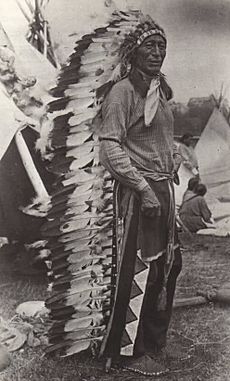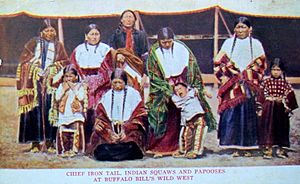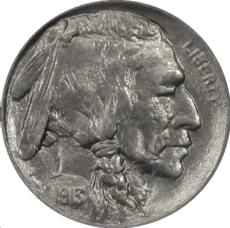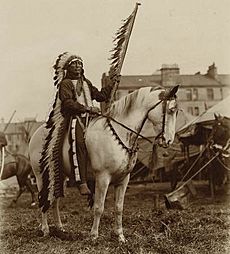Iron Tail facts for kids
Quick facts for kids
Iron Tail
|
|
|---|---|
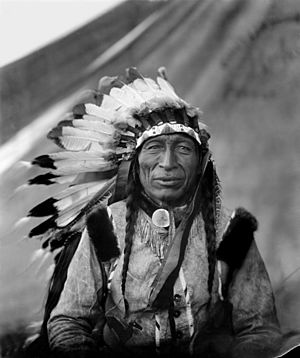
Iron Tail in 1905
|
|
| Born | 1842 |
| Died | May 29, 1916 (aged 73–74) |
| Nationality | Oglala Lakota |
| Occupation | Wild Wester |
| Known for | Oglala Lakota chief, model for the Buffalo nickel |
Iron Tail (whose name in the Lakota was Siŋté Máza) was an Oglala Lakota Chief. He was born in 1842 and passed away on May 29, 1916. Iron Tail became a famous performer with Buffalo Bill's Wild West show. He was one of the most well-known Native American celebrities in the late 1800s and early 1900s. Many photographers took his picture, and his image was shared all over the world. Iron Tail is especially famous in American history because his face was used on the Buffalo nickel, also called the Indian Head nickel, from 1913 to 1938.
Contents
Discovering Iron Tail's Name
Siŋté Máza was Iron Tail's tribal name. People often asked him why white people called him Iron Tail. He explained that when he was a baby, his mother saw a group of warriors chasing buffalo during a big hunt. The buffalo's tails stood straight up, like strong pieces of steel. Because of this, his mother named him Siŋté Máza, which was a new and special name.
Iron Tail and Iron Hail: A Common Mix-Up
Chief Iron Tail is sometimes confused with Chief Iron Hail, also known as Dewey Beard. They were both Lakota men living at the same time, and their names sounded similar. Many history books incorrectly say that Iron Tail fought in the Battle of the Little Bighorn. They also wrongly state that his family was killed at Wounded Knee in 1890. In truth, it was Iron Hail who experienced these tragic events.
Major Israel McCreight, a friend of Iron Tail, shared some important facts about him. He said Iron Tail was not a war chief and did not have a big record as a fighter. He was not a medicine man either. Instead, Iron Tail was a wise advisor and a skilled diplomat. He was always dignified and quiet, and he never boasted. He rarely gave speeches and did not care much for fancy clothes. In this way, he was much like the famous War Chief Crazy Horse. Iron Tail always had a smile and loved children, horses, and his friends.
Iron Tail's Adventures with Buffalo Bill
Iron Tail was known all over the world. He performed as a lead act with Buffalo Bill's Wild West show in famous places. These included the Champs-Élysées in Paris, France, and the Colosseum in Rome, Italy. In both France and England, Buffalo Bill and Iron Tail were honored by important people.
Iron Tail was one of Buffalo Bill's best friends. They often went on annual trips together to hunt elk and bighorn sheep. During one visit to Major Israel McCreight's home, Buffalo Bill asked Iron Tail to show how he played and won a poker game. This was a game he played with U.S. Army officials during a treaty meeting long ago. Iron Tail acted out the whole game, from dealing cards to betting and drawing the last card. He did not say a word, and his face was like a statue. Suddenly, he swept all the chips into his blanket, stood up, and walked away. It was an amazing and very funny performance. Iron Tail continued to travel with Buffalo Bill until 1913. After that, he joined the Miller Brothers 101 Ranch Wild West show until he passed away in 1916.
Iron Tail and Photographer Gertrude Käsebier
Capturing Images of the Sioux
Gertrude Käsebier was a very important American photographer in the early 1900s. She was best known for her powerful pictures of Native Americans. Käsebier spent her childhood on the Great Plains, living near and playing with Sioux children.
In 1898, Käsebier watched Buffalo Bill's Wild West troupe parade past her studio in New York City. They were on their way to Madison Square Garden. Her fond memories and respect for the Lakota people inspired her. She wrote to Buffalo Bill, asking if she could photograph the Sioux who were traveling with his show. Buffalo Bill and Käsebier both deeply respected Native American culture and were friends with the Sioux. Buffalo Bill quickly agreed to Käsebier's request. She started her project on Sunday morning, April 14, 1898. Käsebier's goal was purely artistic. Her photos were not for selling and were never used in Buffalo Bill's show programs or advertisements.
A Photo Session with Chief Iron Tail

Käsebier took classic photographs of the Sioux when they were relaxed. Chief Iron Tail was one of her most challenging subjects to photograph. Käsebier's session with Iron Tail is her only story that was written down.
Before visiting Käsebier's studio, the Sioux at Buffalo Bill's Wild West Camp gathered. They shared their best clothing and accessories with those chosen to be photographed. Käsebier admired their effort. However, she wanted to photograph a "real raw Indian, the kind I used to see when I was a child." She was thinking of her early years in Colorado and on the Great Plains. Käsebier chose Iron Tail to photograph without his fancy clothes. He did not mind. The photo she took was exactly what Käsebier had imagined: a calm, personal, quiet, and beautiful picture of the man. He was without decorations, showing himself to her and the camera openly.
A few days later, Iron Tail was given the photograph. He immediately tore it up, saying it was too dark. Käsebier photographed him again, this time with his full feather headdress. He was very happy with this second picture.
Chief Iron Tail was a global celebrity. He appeared in his fine clothing as the lead with Buffalo Bill in Paris, France, and Rome, Italy. Iron Tail was an excellent performer and was not pleased with the relaxed photo of him. But Käsebier chose it as the main picture for an article in Everybody's Magazine in 1901. Käsebier believed all her portraits "revealed Indian character." She felt they showed the strength and unique spirit of the Native Americans in "new ways for the Sioux."
The Indian on the Nickel Coin
In the early 1900s, Iron Tail's unique face became well known across the United States. He was one of three people who modeled for the five-cent coin called the Buffalo nickel or Indian Head nickel. This popular coin was first made in 1913. It shows the natural beauty of the American West.
Bee Ho Gray, a famous Wild West performer, went with Iron Tail. He acted as an interpreter and guide in Washington D.C. and New York. There, Iron Tail modeled for sculptor James Earle Fraser. Fraser was working on designs for the new Buffalo nickel. Iron Tail was the most famous Native American of his time. He was a popular subject for professional photographers, who shared his image around the world.
Iron Tail's Friendship with Major Israel McCreight
Chief Iron Tail was a good friend of Major Israel McCreight. He often visited McCreight's home, called The Wigwam, in DuBois, Pennsylvania. Iron Tail and Chief Flying Hawk considered The Wigwam their home in the East.
On June 22, 1908, Iron Tail led a special ceremony at Buffalo Bill's tent. During this ceremony, McCreight was adopted as an honorary Chief of the Oglala Lakota. In 1915, McCreight hosted a big party for Iron Tail and Flying Hawk at The Wigwam.
The Adoption of Čhaŋté Tȟáŋka
On June 22, 1908, Iron Tail and "Buffalo Bill" Cody visited DuBois, Pennsylvania with the Wild West Congress of Rough Riders. Twelve thousand people came each day to see Cody's Wild West shows. One hundred fifty Oglala people were in town with 150 ponies.
On this day, Iron Tail led the adoption ceremony for Major Israel McCreight. McCreight became an honorary Chief of the Oglala Lakota. Iron Tail named McCreight "Čhaŋté Tȟáŋka" (which means "Great Heart"). The ceremony took place at Buffalo Bill's tent. Chief American Horse, Chief Whirlwind Horse, Chief Lone Bear, and 100 Oglala Lakota members of the Wild West Congress of Rough Riders were there.
The Oglala Lakota chiefs formed a small circle around McCreight and his wife, Alice. Iron Tail began the ceremony with a speech in Lakota. He gave a hearty handshake to everyone. Then, he placed a war bonnet on McCreight's head and moccasins on his feet. Iron Tail then gave McCreight a tepee. An owl had been drawn on it with yellow chalk. Iron Tail said this tepee was for him and Alice to live in. Tom-tom drums were beaten, and tribal songs were sung loudly. Iron Tail made some final remarks and ended with more hearty handshakes.
Iron Tail and Buffalo Bill were then driven in a new 1908 Rambler car to McCreight's house for a banquet. There, Iron Tail received a new Winchester rifle as a gift to remember the event. McCreight was deeply touched by the seriousness of the occasion. He carried the honor proudly for the rest of his life. McCreight later said that being an honorary Chief of the Oglala Lakota was a much greater honor than any president or military group could have given him.
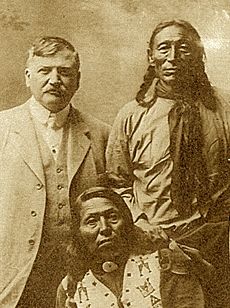
Iron Tail's Last Days
In May 1916, Chief Iron Tail, at 74 years old, became sick with pneumonia. He was performing with the Miller Brothers 101 Ranch Wild West show in Philadelphia, Pennsylvania. He was taken to St. Luke's Hospital. Buffalo Bill had to continue his show the next day in Baltimore, Maryland. Iron Tail was left alone in a strange city with doctors and nurses who could not talk to him.
McCreight learned about Iron Tail being in the hospital from the Philadelphia newspaper that morning. He immediately sent a telegram to Buffalo Bill. He asked Buffalo Bill to send Iron Tail by the next train to Du Bois, Pennsylvania, so he could be cared for at The Wigwam. No reply came, and the telegram was not delivered or sent to Baltimore. Instead, the hospital staff put Iron Tail on a Pullman train, with a ticket home to the Black Hills.
On May 28, 1916, when the train porter went to wake him in South Bend, Indiana, Iron Tail had passed away. His body continued on to its destination. Buffalo Bill expressed sadness that the Chief was sent to the hospital and that he had not received McCreight's telegram. Iron Tail's body was moved to a hospital in Rushville, Nebraska. Then, it was taken to the Pine Ridge Indian Reservation. He was buried at Holy Rosary Mission Cemetery on June 3, 1916.
With deep emotion, Buffalo Bill said he would place a granite stone on Iron Tail's grave. It would have a copy of the Buffalo nickel carved on it, since Iron Tail had posed for the coin. However, Buffalo Bill passed away on January 10, 1917, just six months after Iron Tail's death. In a ceremony at Buffalo Bill's grave on Lookout Mountain, west of Denver, Colorado, Chief Flying Hawk placed his war staff of eagle feathers on the grave. Each of the experienced Wild Westers placed a Buffalo nickel on the large stone. This was a symbol of the Indian, the buffalo, and the scout, who had represented the early history of the American West since the 1880s.


